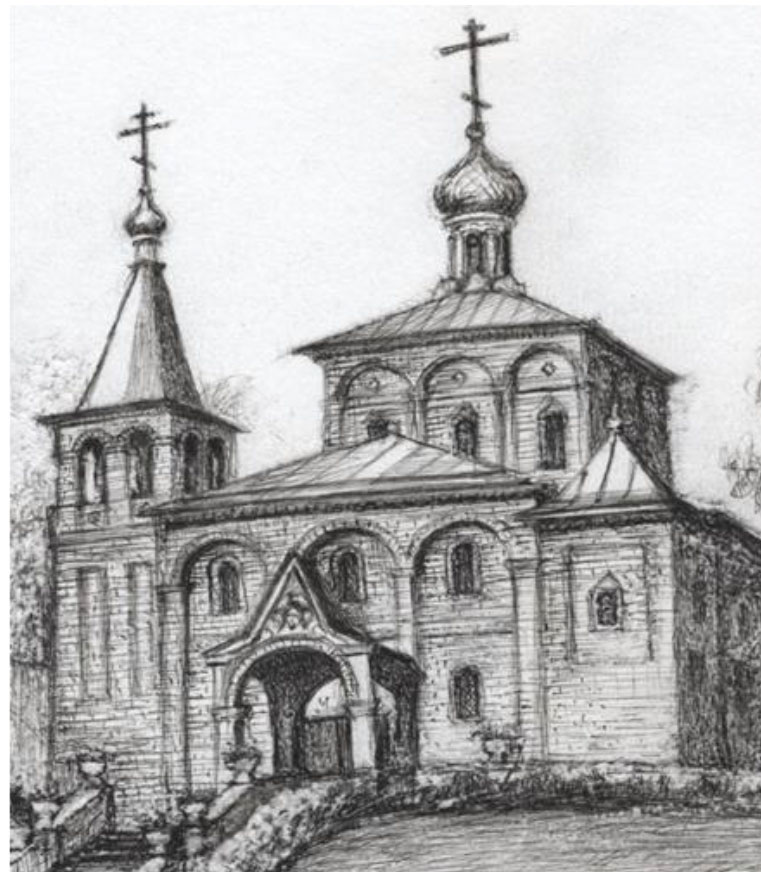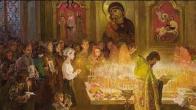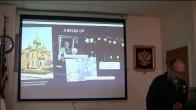You are here
St. Herman of Alaska
12/25 December
 Venerable Herman of Alaska was born in the town of Serpukhov, near Moscow, in 1757, into a merchant family. At the age of sixteen, he entered onto the monastic path. In the beginning, the Venerable one bore obedience in the Trinity-Sergius Hermitage, situated in the environs of Petersburg, on the shore of the Gulf of Finland.
Venerable Herman of Alaska was born in the town of Serpukhov, near Moscow, in 1757, into a merchant family. At the age of sixteen, he entered onto the monastic path. In the beginning, the Venerable one bore obedience in the Trinity-Sergius Hermitage, situated in the environs of Petersburg, on the shore of the Gulf of Finland.
The future missionary struggled in the monastery about five years. Desiring total solitude and silence, Venerable Herman left for Valaam. After a thorough trial by means of various obediences, Hegoumen Nazarius blessed the young ascetic to take up permanent residence in the forest, in desert solitude. When he would come to the Monastery on feast days, the Venerable one bore an obedience on the kliros (he had an excellent voice). Saint Herman received the monastic tonsure in Valaam Monastery.
There is an opinion that Saint Herman arrived on Valaam in 1778. In the same year, Venerable Seraphim of Sarov arrived at the Sarov Monastery. The circumstances of Venerable Herman’s life on Valaam are reminiscent of the solitary struggles of his great contemporary, the wonderworker of Sarov.
Like Venerable Seraphim, the Valaam ascetic was distinguished by an exceptional and penetrating knowledge of the spirit and letter of Sacred Scripture and the works of the holy fathers and teachers of the Church.
The spiritual director and preceptor of the future missionary was Hegoumen Nazarius, a Sarov elder, who introduced the rule of the Sarov Hermitage on Valaam. In this way, the grace-filled regime of Sarov asceticism, in which the spiritual growth of Venerable Herman was accomplished on Valaam, became an inalienable part of his soul and made him akin and exceptionally close in spirit to Venerable Seraphim, the wonderworker of Sarov. There is information that Venerable Seraphim, in his turn, made use of the instructions of Elder Nazarius during the latter’s residence in Sarov.
After a fifteen-year stay by Venerable Herman on Valaam, the Lord summoned the humble monk to the apostolic ministry and sent him to preach the Gospel and to baptize the pagans of the sparsely inhabited and harsh territory of Alaska and the islands of North America adjoining it. With this aim, a spiritual mission, which received the name Kodiak, was founded in 1793, with its center on Kodiak Island. Archimandrite Joasaph (Bolotov), a monk of Valaam Monastery, was appointed the director of the Mission. Among the other fellow-workers of the Mission were five more monks from Valaam Monastery, among them also Venerable Herman, whom the Lord blessed to labor in evangelism longer and more fruitfully than any other of the Mission’s members.
Upon arrival on Kodiak Island, the missionaries immediately occupied themselves with building a church and converting the pagans. "Since the 24th of September 1794, I have been living on Kodiak Island. Glory be to God, I have baptized more the 700 Americans and have performed more than 2000 weddings; we have built a church, and if time permits - we shall build another, and two field churches, and then it will be necessary to build a fifth also", Archimandrite Joasaph remarks in one of his letters.
In the new place, Father Herman at first bore an obedience in the bakery and was occupied with the Mission’s economic concerns. The Mission was not found long under the direction of Archimandrite Joasaph (later Bishop): during a storm (in 1799), the Most Reverend Joasaph perished with his fellow-travelers in the waves of the ocean. To the aid of the missionaries who remained alive, only one hieromonk of the Alexander Nevsky Lavra, Gideon, was dispatched in 1804. He headed the Mission for a certain time. Through his solicitude, a school for the children of baptized Aleuts was established. In 1807, Hieromonk Gideon left the camp of the missionaries forever, having laid all responsibility on Venerable Herman, who until his very end remained the spiritual father, pastor and guardian of the human souls in the Mission entrusted to him. They wanted to ordain the Venerable one to the dignity of hieromonk and to elevate him to archimandrite, but the humble monk refused any elevation whatsoever and to the end of his days abode a simple monk.
Venerable Herman was a true good shepherd for the local inhabitants, and he defended them, as he could, from evil and predatory men, who saw in the islanders only an object for cruel exploitation.
Unwaveringly and persistently, not having any support besides his flaming faith, the Elder continued his succor of the offended and oppressed, seeing in this his duty and calling, the essence of which he expressed in astonishingly simple words: "I am the lowest servant of the peoples here and their nurse".
Father Herman lived at first near the church of the Mission, on Kodiak, but afterwards moved to nearby Spruce Island, which he named "New Valaam". Spruce Island was the last refuge in the holy Elder’s very arduous apostolic wanderings.
Once, an inundation occurred on Spruce Island. The inhabitants came running to the Elder in alarm. He took an icon of the Mother of God from the orphanage and placed it on a laida, that is, on a silted-in shoal, and began to pray. After the prayer, turning to those present, he said: "Fear not; the water will not approach further than this spot where the icon is standing". The Venerable one’s word was fulfilled. After that, promising the same help from the icon in future times also, he charged his disciple, Sofia Vlasova, in case of inundation, to place the icon on the laida.
Venerable Herman foretold the time of his end to his spiritual children and explained how to bury him. On 13 December 1837, he asked that candles be lit before the icons and that the Acts of the Holy Apostles be read. During the reading about the labors of the holy evangelizers, the holy Elder Herman passed from earthly labors to heavenly repose in the eighty-first year of his life. Over the Elder’s grave, originally a simple wooden memorial was put up, then a modest wooden church, consecrated in the name of Venerable Sergius and Herman, the wonderworkers of Valaam, was erected.
"Even though much time will pass after my death", Venerable Herman would say to his disciples, "still I shall not be forgotten, and the place of my habitation will not be empty; a monk like me, fleeing human glory, will came and will live on Spruce Island - and Spruce Island will not be without people!" And indeed, after seventy-nine years, Archimandrite Gerasim (Schmaltz) - a missionary from Russia - settled on Spruce Island and lived there for forty years. In 1970, Venerable Herman was numbered among the choir of the saints. Numerous pilgrims from all the ends of the earth visit Saint Herman’s places in Alaska every year.
PARISH LIFE
RECENT VIDEOS
Address of our Cathedral
Subscribe to our mailing list
While all the materials on this site are copyrighted, you may use them freely as long as you treat them
with respect and provide attribution on the Russian Orthodox Cathedral of St.John the Baptist of Washington DC.









